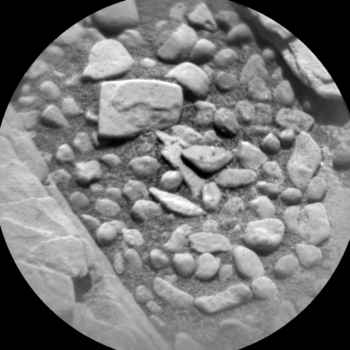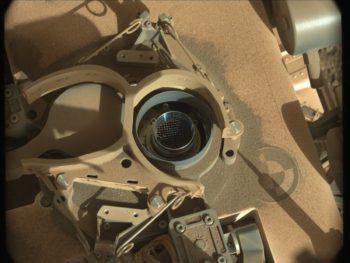NASA’s Curiosity Mars rover has just started Sol 2546 duties.
Reports Roger Wiens, a geochemist at Los Alamos National Laboratory in New Mexico, Curiosity is going through its list of analysis details that take place after taking a drill sample.
A recent main activity by the Mars machinery is a SAM (Sample Analysis at Mars) gas chromatograph column clean-up.
Remote-sensing data
Meanwhile, there has been time to take environmental observations and more remote-sensing data.
A Curiosity carried-out plan had quite a diversity of targets.

Curiosity Chemistry & Camera (ChemCam) photo acquired on Sol 2544, October 2, 2019.
Credit: NASA/JPL-Caltech/LANL
“Having analyzed enough of the nearby bedrock, our attention has turned to white vein materials,” Wiens explains. For example, a recently taken Remote Micro-Imaging (RMI) photo shows Sol 2533 target “Glen Lyon,” which has some white material in the veins in the bedrock, he points out.
Curiosity’s Chemistry and Camera (ChemCam) is targeting a wide white vein in today’s plan, called “Bighouse.” Another type of target, pebbles.
“For those, ChemCam has a target at 2.3 meters called “Sliddery” using a 3×3 raster. ChemCam will add another row of RMI images (“Stony Side 2”) to a mosaic of a ridge located 180 meters from the rover,” Wiens adds.
The rover’s Mastcam was slated to take documentation images of the ChemCam targets, and the Hazcams will take images of the near-rover field of view.
Environmental measurements
The second day of the plan had several environmental measurements, including a Mastcam crater rim extinction and a Sun tau, that is tracking the amount of dust in the Martian atmosphere using a measurement of opacity called “tau.” The lower the tau, the clearer the air.
Navcam will take a dust devil survey, a suprahorizon movie, a sky survey, and a zenith movie. There is also a DAN (Dynamic Albedo Of Neutrons) active observations, along with the robot’s RAD (Radiation Assessment Detector) and REMS (Rover Environmental Monitoring Station) taking data.







